Chapter 2—
The Setting
The appearance of the Grimaldi Chapel, which can be re-created according to available sources, although these are incomplete, sets the stage for a critical analysis of its art program and the narrative style of its reliefs. To reestablish the original context for Giambologna's bronzes, a task central to my argument, I summarize here what is known about the chapel and reinterpret some of the sources.[1]
The Grimaldi Chapel bronzes, now in the chapel and Aula Magna of the University of Genoa, comprise seven reliefs depicting scenes from the Passion of Christ, six Virtues, and six angels. The reliefs are Christ before Pilate, The Flagellation, Christ Crowned with Thorns, Ecce Homo, Pilate Washing His Hands, The Way to Calvary , and The Entombment (Plates 7–12, Fig. 5). The Virtues are Faith, Hope, Charity, Justice, Fortitude , and Temperance (Plates 2–6, Fig. 4). Of these works, all but The Entombment are mentioned in the contract for the chapel executed on 24 July 1579.[2] There was also a bronze crucifix, since lost, as well as two paintings, The Sacrifice of Isaac and Joseph Sold into Egypt (Fig. 16; Plate 13), by the Pisan artist Aurelio Lomi, probably painted in the 1590s.[3] Levati, biographer of the Genoese doges, mentions a magnificent tomb, which must have disappeared with the church, and a bronze statue of Grimaldi that has not surfaced. Evidently there were also stuccos, destroyed with the church, for Giulio Negrone refers to them in his oration celebrating the coronation of Luca Grimaldi as doge in 1605.[4] Figures 17 and 18 show
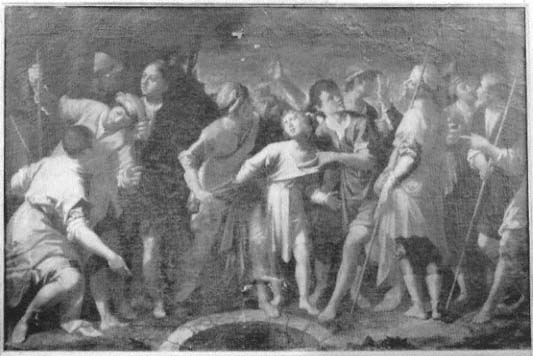
Figure 16.
Aurelio Lomi, Joseph Sold into Egypt , c. 1597.
Convento di San Antonio, Gaggiola (La Spezia).
my suggested placement of the Grimaldi Chapel's principal features and its original appearance.
At the height of the sixteenth-century renovation activities in San Francesco di Castelletto, Giambologna entered the picture. From correspondence, it is clear that he was called to Genoa by the doge and governors, who negotiated directly for his services with Francesco de' Medici, grand duke of Tuscany.[5] Although it is not clear whether these services included work for the Grimaldi Chapel, it is reasonable to assume that they did because the contract for the chapel was signed during Giambologna's trip to Genoa in July 1579. It seems unlikely that the idea to have Giambologna decorate the Grimaldi Chapel occurred suddenly to Luca Grimaldi while the sculptor was in Genoa on other business. The correspondence, which reveals that Giambologna's assignment in Genoa was of public importance, suggests that the Grimaldi Chapel was intended as a major Genoese monument. Local talent, however, was ap-
parently far too modest to satisfy Genoese aspirations; only the best in all Europe would do. Other artists had been imported in the past by the Genoese, including Matteo Civitale (1436–1501) and Andrea Sansovino (c. 1467–1529), who were called by the Padri di Comune to work in the Chapel of Saint John the Baptist in the duomo, and Perino del Vaga, who remodeled and redecorated the Palazzo del Principe for Andrea Doria from about 1528 to 1533.[6] Galeazzo Alessi, the Perugian architect, was also a significant presence in Genoa in mid-century, designing Santa Maria Assunta in Carignano, renovations in the cathedral, various villas, and other works.[7]
The altar chapel in San Matteo that Giovanni Montorsoli executed between 1543 and 1547 for Andrea Doria, though not similar in layout to the Grimaldi Chapel, was the most lavish and prestigious precedent for it in Genoa.[8] Doria, as patron of both secular and religious art, intended to unite these two spheres in one glorious triumphant statement celebrating the supremacy of Genoa and his part in it. There is a relic of the cross in the crypt of Doria's funerary chapel, as there was in the Grimaldi. Grimaldi, unlike Doria, could not expect to make an entire church into a family mausoleum, but he could rival and even surpass the Doria in the decorative splendor achieved in a single chapel. Montorsoli's marble statues around the apse of San Matteo are impressive but hardly as magnificent as Giambologna's golden bronzes of Virtues and reliefs in combination with the colored marbles, stuccos, and paintings of the Grimaldi Chapel.
The precise influence the Genoese exercised over Francesco de' Medici to secure Giambologna's services remains a mystery. It may have had to do with a mission entrusted to Luca Grimaldi in 1577 to carry official congratulations to the duke on the birth of his son.[9] Either on this mission or at another time Grimaldi was also able to resolve a jurisdictional dispute over the territory of Lunigiana, greatly to the relief of Genoa. A rare glimpse of the bite of individual personality appears in a letter Grimaldi wrote from Florence to the doge, in which he relates some details of his visit. He was irritated that the grand duke was not in town when he arrived and annoyed that he was lodged, not in the ducal palace, where the ambassador of Savoy stayed, but in the house of Bartolomeo Fornari, who, nevertheless, showed him every courtesy.[10] In addition to diplomatic contacts such as the one just described, other ties between Genoa and Florence were customary; undoubtedly the powerful Genoese Banco di San Giorgio was doing business with the Medici
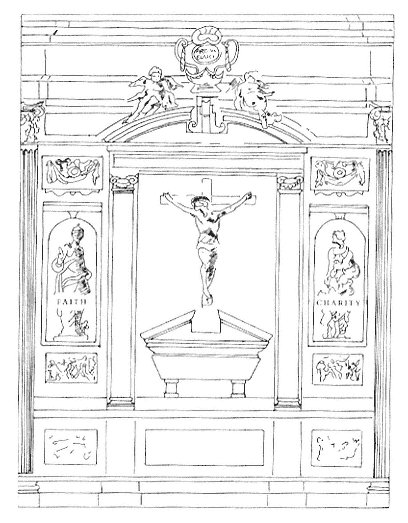
Figure 17.
Author's reconstruction of the altar wall, Grimaldi Chapel.
as well. Fortunately for Genoa, Grimaldi, and posterity, Grand Duke Francesco did release Giambologna for the commission. And by all accounts the Grimaldi Chapel lived up to expectations. Negrone was unstinting in his praise, observing that it was "full of devotion" because of the many important indulgences attached to it, declaring that it had become a model of its kind and had stimulated other wealthy families to decorate the churches of Genoa in an opulent manner.[11]
The link between Giambologna and Luca Grimaldi may have been created during Luca's ambassadorial mission in 1577. At that time Giambologna and his future patron might easily have met, and Grimaldi must certainly have seen the sculptor's work.[12] At some point, if not in Flor-
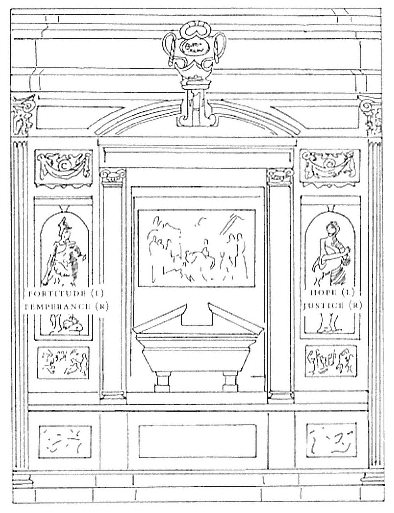
Figure 18.
Author's reconstruction of the lateral walls, Grimaldi Chapel, with
position of Virtues indicated.
ence then in Genoa, Grimaldi saw Giambologna's bronze statuette the Rape of the Sabine (Fig. 19), made for the duke of Parma. He was so impressed with it that he stipulated in the Grimaldi contract that the Farnese statuette was the standard against which Giambologna's chapel bronzes would be judged.[13] The choice of bronze for the chapel sculpture is in itself remarkable. Giambologna was just as expert in marble as in bronze, and while he was creating the bronze reliefs for the Salviati Chapel in San Marco, Florence, he was making the saint statues for the same chapel in marble. Bronze, highly regarded since antiquity as a medium, was given first place by Pliny in his Historia Naturalis and by Pomponius Gauricus in his De Sculptura of 1504.[14] Ancient precedent,
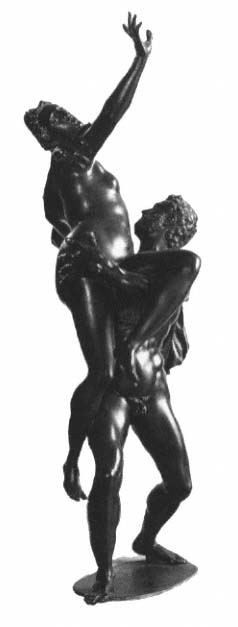
Figure 19.
Giambologna, Rape of the Sabine , 1579.
Bronze statuette, 98 cm.
Museo e Galerie Nazionali di Capodimonte, Naples.
the aesthetic appeal of bronze, and a desire on the part of both patron and artist to surpass prior monuments all must have figured in the choice.
Another link between Luca Grimaldi and Giambologna was probably the painter Luca Cambiaso, who witnessed the Grimaldi Chapel contract and whose involvement in the chapel will be discussed later. According to Soprani, Cambiaso was presented to the grand duke in Florence in 1575 and undoubtedly had the opportunity not only to meet
Giambologna, if they had not met before, but also to see his work. Possibly Cambiaso himself urged Grimaldi to engage Giambologna for his chapel. The Genoese painter Giovan Battista Paggi was a further tie between Genoa and Giambologna, who befriended Paggi while he was living in Florence during the 1580s and 1590s.[15]
Although there are lacunae in our information on many details of the Grimaldi commission, we can read between the lines for clues. The correspondence between the Genoese government and Francesco de' Medici (8 May, 26 May, 28 July) indicates that Giambologna was responsible for architectural decoration while in Genoa; we might thus assume that the decoration for the Grimaldi Chapel was included.[16] Andrew Morrogh's suggestion that Giambologna derived his ideas for the Salviati Chapel from Palladio is intriguing; if borne out, it would explain the similar articulation of the Grimaldi Chapel walls.[17] Assuming, then, that Giambologna, even if only through adaptation, was responsible for the architectural design of the Grimaldi Chapel, we must look to other architectural works by him for clues to its appearance. Three monuments illustrate the pedimental decoration and wall arrangements he favored: the Altar of Liberty, 1577, in the cathedral of Lucca; the Salviati Chapel, completed in 1585, in the Church of San Marco in Florence; and the artist's own burial chapel, the Soccorso Chapel, in Santissima Annunziata, Florence, begun in 1594. The two works closest in date to the Grimaldi Chapel, the Altar of Liberty (see Fig. 24) and the Salviati Chapel (see Figs. 20–22), are more exuberant, more sculptural in design, and spatially more complex than the later chapel in the Annunziata (see Fig. 25), where the architectural decoration is flatter and more subdued, even to the point of austerity. In all three monuments, however, Giambologna's organizing motif was the tripartite scheme also used for the walls of the Grimaldi Chapel.
Of the three works just mentioned, the Salviati Chapel is the one most similar to the Grimaldi in scale, layout, and decorative components. In fact its design just preceded that of the Grimaldi Chapel. Built and decorated on commission from the Salviati family, the chapel is Giambologna's most important extant architectural and sculptural complex. According to documents heretofore unpublished, payments for the Salviati Chapel had begun at least by 13 June 1579.[18] On that date Jacopo di Zanobi Piccardi, a stone carver from Rovezzano, was to be paid 100 gold scudi for marble to be brought from Carrara for the Chapel of Saint Antoninus, San Marco, Florence. The plans for the Grimaldi Chapel, if they were devised by Giambologna, can hardly have
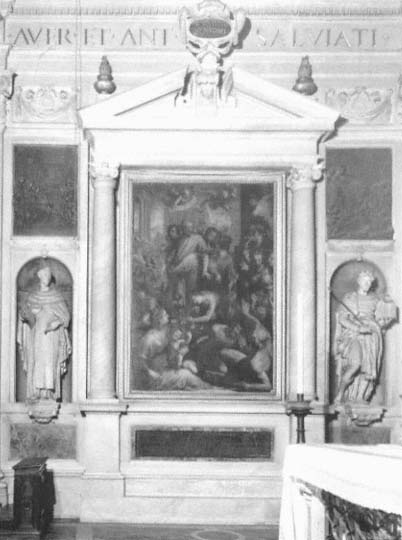
Figure 20.
Giambologna, Salviati Chapel, c. 1579, left wall.
San Marco, Florence.
been worked out before his visit to Genoa in July 1579, by which time the Salviati Chapel was already under way. This chapel thus serves as the major visual source for reconstructing the Grimaldi Chapel. The bronze reliefs for the Salviati Chapel were also begun, and presumably therefore designed, earlier than those for the Grimaldi.[19]
In the Salviati Chapel (Figs. 20–22) the central motif of each of the three walls is an aedicula framing a painting, consisting of an engaged
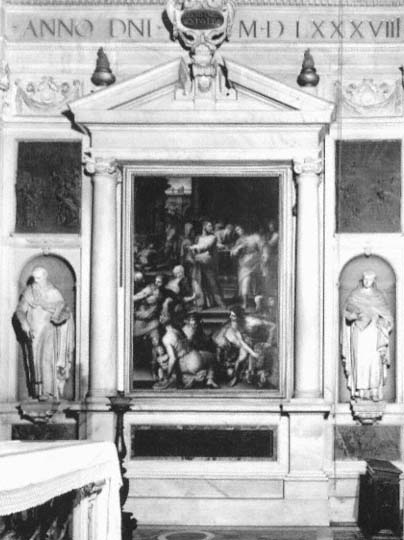
Figure 21.
Giambologna, Salviati Chapel, c. 1579, right wall.
San Marco, Florence.
column on each side raised on a socle and crowned by a triangular broken pediment on the lateral walls and a segmental broken pediment on the altar wall (Fig. 23). The dadoes under the column bases are enlivened by colored marble panels. The aedicula in each case is flanked by statues of saints in roundheaded niches, and the whole wall is enclosed by colossal composite pilasters, with an entablature above running around the three walls of the chapel. Angels recline on the segmental
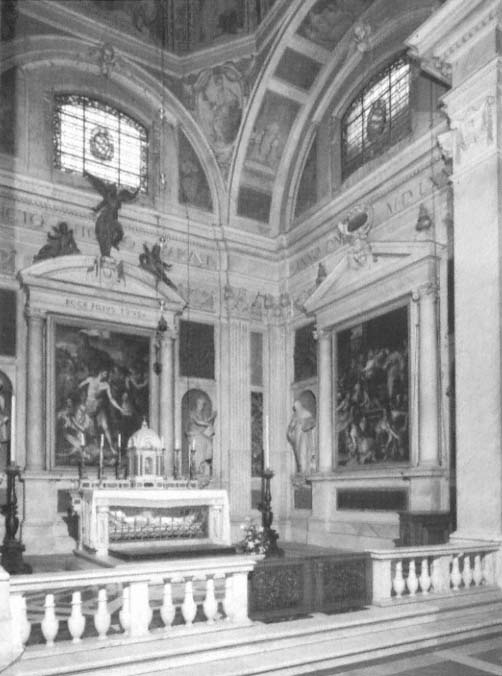
Figure 22.
Giambologna, Salviati Chapel, c. 1579, altar wall.
San Marco, Florence.
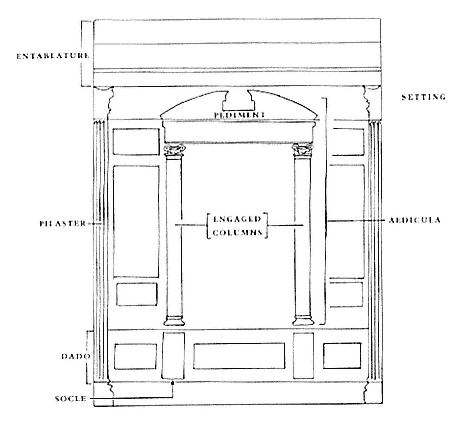
Figure 23.
Diagram of architectural terms, Grimaldi Chapel.
pediment of the central aedicula, as they do on the Altar of Liberty (Fig. 24), but the architectural decoration and decorative detail produce a simpler and more subdued overall effect in the Salviati Chapel than they do on the Altar of Liberty. The aediculae in the chapel, instead of projecting like porticoes, as in the Altar of Liberty, are set back against the wall with minimal projection. While the pediments have a break at the peak, the moldings are not otherwise interrupted, as they are in the Altar of Liberty, by an entirely different motif. Giambologna's own burial chapel, the Soccorso Chapel (Figs. 25, 26), austere in design and color by comparison with the two earlier works, does have the same combination of niches filled with sculpture flanking a central image, but it lacks aediculae.
Probably all the aediculae in the Grimaldi Chapel resembled the one on the altar wall of the Salviati Chapel, with its segmental pediment. The posture of the angels (Figs. 6, 7) intended for the pediments in the
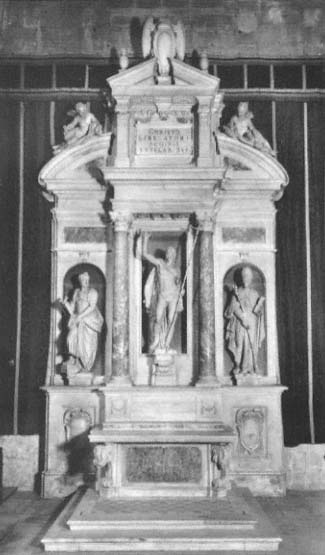
Figure 24.
Giambologna, Altar of Liberty, 1577–79, marble.
Duomo, Lucca.
Grimaldi Chapel suggests this, corresponding as it does to that of the angels on the Altar of Liberty and on the Salviati altar wall. In a drawing of a proposed design for the altar wall of the Salviati Chapel (Fig. 27), angels recline on a simple broken pediment; evidently the scheme was unsatisfactory, because it was discarded in the final execution. The sumptuousness of the Grimaldi Chapel would have been enhanced by colored marble panels set not only into the walls above the Virtue stat-
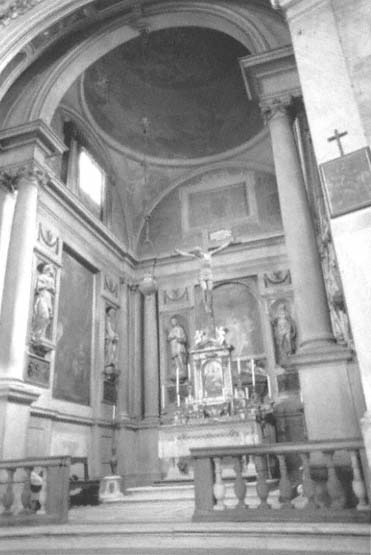
Figure 25.
Giambologna, Soccorso Chapel, c. 1594.
Santissima Annunziata, Florence.
ues but in the dado as well, as in the Salviati Chapel, where at least seven different colors of marble are visible on the walls and in the floor: black, black flecked with rose, white, maroon with rose, red, umber, green.[20] To bring all the elements of the design together, colossal composite pilasters would then have framed each wall at the corners. Above, the three walls would have been tied together by a continuous entablature. In sum, the only significant differences in architectural design be-
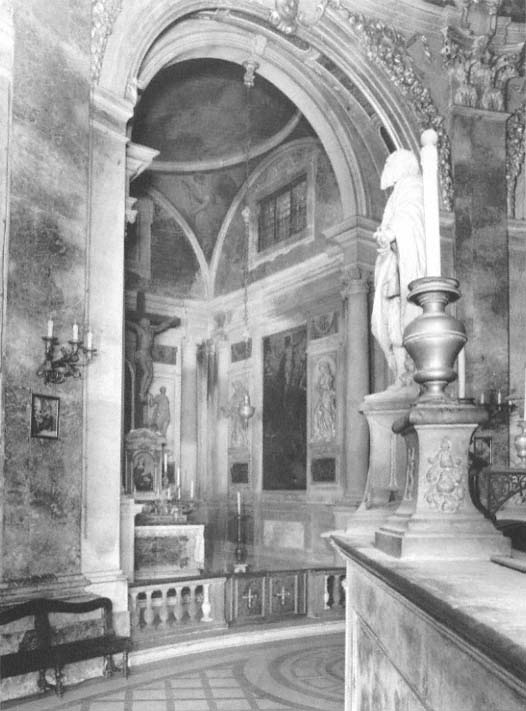
Figure 26.
Giambologna, Soccorso Chapel, c. 1594, right wall.
Santissima Annunziata, Florence.
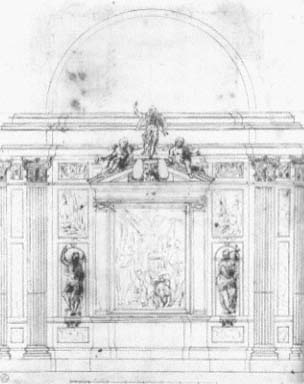
Figure 27.
Study for the altar wall of the Salviati Chapel, c. 1580, no. 237A,
Gabinetto Disegni e Stampi degli Uffizi, Florence.
tween the Grimaldi Chapel (Figs. 17, 18) and the Salviati (Figs. 20–22) seem to have been the shape of the side wall pediments and the placement of the bronze reliefs and marble panels. Otherwise, the combination of paintings framed by aediculae and niches with sculpture was probably similar.
Although the Salviati Chapel must be the principal guide to a reconstruction of the Grimaldi, there are other, more general, precedents. The idea of combining painting and niches with sculpture in one chapel, as was done in both the Salviati and Grimaldi chapels, developed in the sixteenth century. Giambologna would have been familiar with such combinations in both Rome and Florence. When he arrived in Rome for the first time in 1554, Vasari and Ammanati had just finished the Del Monte Chapel (Fig. 28) in San Pietro in Montorio, an important work combining painting and niches with sculpture.[21] The wall
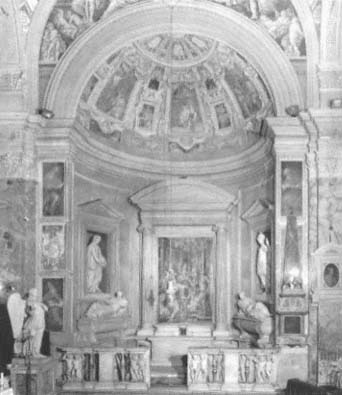
Figure 28.
Vasari and Ammanati, Del Monte Chapel, begun 1550.
San Pietro in Montorio, Rome.
arrangement in the Del Monte Chapel resembles a single wall of the Grimaldi Chapel. Shaped like a deep niche, the Del Monte has over the altar one large painting framed by an aedicula with a segmental pediment and flanked by Virtues, each in a niche. In Florence, when he was still struggling to make a name for himself in the 1560s, Giambologna was involved in sculpture for the Chapel of San Luca in Santissima Annunziata. This elaborate chapel (begun 1565; Fig. 29) for the artists' guild also combines painting and sculptural niches.[22]
One Genoese precedent, close in time to the Grimaldi Chapel, is the Lercari Chapel, situated to the left of the choir in the Cathedral of San Lorenzo (Fig. 30). Here, on the lateral walls, in a tripartite architectural framework, four Virtues (Faith, Hope, Charity, and Prudence) in niches flank paintings that simulate sarcophagi surmounted by seated effigies of the patrons. A relief is located above each niche; covering the entire
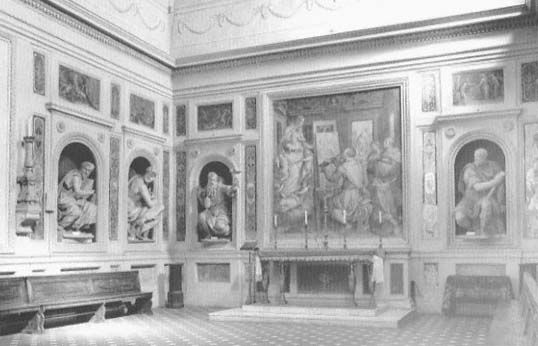
Figure 29.
Chapel of San Luca, c. 1565–76.
Santissima Annunziata, Florence.
wall above each funerary monument is a painting (Marriage of the Virgin and Presentation in the Temple ).[23] Grimaldi was undoubtedly impressed by the Lercari and favored the inclusion of the Virtues and the combination of three-dimensional sculpture and relief with painting. Another influential factor must have been the involvement of Luca Cambiaso, who witnessed the Grimaldi contract, probably helped in its planning, and had worked in the Lercari Chapel.
A final clue to the broad articulation of the Grimaldi Chapel walls is found in other sumptuous family chapels built by wealthy Genoese in emulation of the Grimaldi. Among these were the Senarega Chapel in the cathedral (1583–93), the Immacolata Chapel and Chapel of Saint John the Baptist in San Pietro di Banchi (1588–90), and the Pinelli (begun 1595; Fig. 31) and Serra chapels (begun 1590) in San Siro. Like the Grimaldi Chapel, the Senarega and the chapels in San Pietro are located in the most prestigious parts of the church, flanking the main altar. Even if there are differences in emphasis and detail, the general articulation of the walls of these chapels is similar to that of the Grimaldi, with the
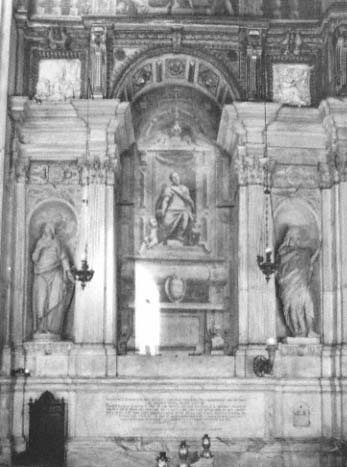
Figure 30.
Lercari Chapel, c. 1565–70. San Lorenzo, Genoa (Prudence on the right).
central aedicula containing a painting, crowned with a pediment, and flanked by statutes in niches. The use of bronze for the statutes and reliefs, however, is unique to the Grimaldi. These later chapels surely reflect the Grimaldi Chapel and confirm its appearance but add no new information to what has been already gathered from other sources.[24]
Several crucial points relating to the chapel's decorative components emerge from a careful reading of the contract and subsequent guide-books. In addition to the six Virtues and Passion reliefs, already mentioned, the contract specifies six bronze angels, a pair over the central image of each wall of the chapel. Two of these images were to be painted panels; the medium for the third was not given. In Soprani's
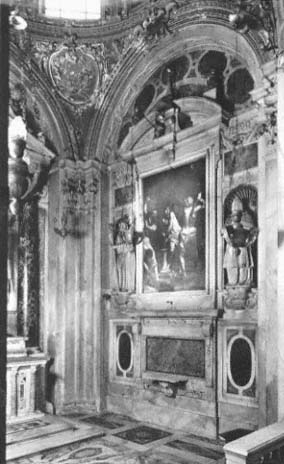
Figure 31.
Pinelli Chapel, 1595–1603. San Siro, Genoa.
1674 guide to artists in Genoa we find, not surprisingly, that the Virtues stood in marble niches, that another relief had been added, making seven, and that there were two oil paintings (Fig. 16; Plate 13) by Aurelio Lomi.[25] It may seem strange to us that Cambiaso, who was closely connected to Grimaldi, was not the author of these paintings. But apparently who was to paint them was decided only after the contract was signed, because they are not specifically assigned; furthermore, by 1583 Cambiaso had left Genoa to work at the Escorial in Spain; he died there in 1585. Moreover, Lomi was a highly regarded and popular painter, judging by his many commissions in and around Genoa and Padua, mentioned by Soprani.
Ratti's 1768 edition of Soprani's book, besides identifying the seventh relief for the Grimaldi Chapel as The Entombment (Plate 12; Ratti says it was the altar frontal) and stating, "Per l'Altare medesimo ei gitto in bronzo l'Immagine del Crocifisso" (For the same altar he cast in bronze the image of the crucifix),[26] also gives the subjects of Aurelio Lomi's two paintings: the Sacrifice of Isaac and Joseph Sold into Egypt.
Although the Grimaldi contract specified Prudence as one of the six virtues and Christ before Pilate as one of the six reliefs, Ratti has substituted Temperance for Prudence and Christ Presented to the High Priest for Christ before Pilate.[27] The change from Prudence to Temperance, which seems confirmed by the statute itself, nevertheless remains problematic. Prudence was traditionally such an important virtue—the first of the cardinal virtues after the three theological ones, according to Aquinas—that it is hard to imagine that it was entirely eliminated from the Grimaldi program or conflated with Temperance and given a subordinate role with only a compass to indicate its presence. Even though the virtue of temperance became increasingly important from the thirteenth century with the revival of Aristotle's Ethics and its emphasis on the golden mean, prudence continued to have an honored place.[28] The prominence of the figure of Prudence in the Grimaldi context emerges in the two orations delivered for Grimaldi's coronation in 1605, which dwell on the virtue at some length. Furthermore, Prudence is depicted with Justice holding the Grimaldi coat of arms on the frontispiece of the published Oratione .[29] Perhaps the lost bronze statue of Grimaldi himself, mentioned at the beginning of this chapter, was intended to embody prudence in some way that we can never know. Or Prudence could have been represented in the chapel's stuccos.
The addition to the chapel after the contract was signed in 1579 of the crucifix and The Entombment mentioned by Ratti, as well as the apparent substitution of Temperance for Prudence, may have been prompted by two factors: the probable transfer of relics of the cross and crown of thorns to the chapel after the signing of the contract and the apostolic visitation of the bishop of Novara, Monsignore Francesco Bossio, in 1582. As will be discussed in connection with the program of the chapel, the practice of venerating relics was reaffirmed by the Council of Trent. It was Luca Grimaldi who had the cross and crown of thorns relics placed in the family chapel. He probably added the crucifix and The Entombment relief in response to the visit of Bossio, who specified that there be a bronze or silver cross in every chapel unless the image
of the crucifix was painted in the altarpiece or on the wall. In the case of the Grimaldi Chapel the crucifix would have been appropriate, for the chapel itself was dedicated to the holy cross. As concluding scenes for the Passion cycle, already stipulated in the contract, both the crucifix and The Entombment made logical additions. The original plan provided for paintings without enumerating their subjects. Lomi's two paintings, The Sacrifice of Isaac and Joseph Sold into Egypt, both represented Old Testament analogues to the Crucifixion. They not only emphasized the chapel's dedication to the holy cross but also focused attention on the act of sacrifice. And Christ's sacrifice on the cross was reenacted with each celebration of the Eucharist.[30]
The visual evidence just reviewed—Giambologna's extant architectural decoration; the precedents of important chapels in Florence, Rome, and Genoa; and the reflections of Giambologna's work in later Genoese chapels—augments the information deduced from the contract and the guidebooks. This evidence establishes that the Virtues in the Grimaldi Chapel flanked the central image on each wall, whether it was a painting or a sculpture. It also gives a reasonably accurate picture of the aediculae. The location of the Passion reliefs remains to be determined.
That the contract specified six Passion reliefs of the same size (the seventh being much larger) and six Virtues suggests that these works were paired on the three walls of the chapel. But the location for the Passion reliefs either above or below the Virtue statues must be established. Giambologna's two extant chapels in Florence, the Salviati Chapel (Figs. 20–22) in San Marco, designed just before the Grimaldi, and the artist's own burial chapel in Santissima Annunziata (Figs. 25, 26), acquired by the artist in 1594, suggest the answer.
Giambologna placed the six narrative reliefs above the statues of saints in their niches in the Salviati Chapel, where these reliefs have a vertical format, about 1.47 × 1.10 meters, instead of a horizontal one and are much larger than the Grimaldi relief panels, which are .47 × .71 meters. The height of the Salviati reliefs is one and a half times the width, whereas the proportions of the Grimaldi are the reverse, with the width about one and a half times the height, like the dark marble panels set into the wall beneath the saint statues in the Salviati Chapel. Because of their size and format the Salviati reliefs had to be placed above, rather than beneath, the saint statues. If we look at one of the Salviati reliefs, Saint Antoninus Reconciling the Signoria (Fig. 32), we see clearly that
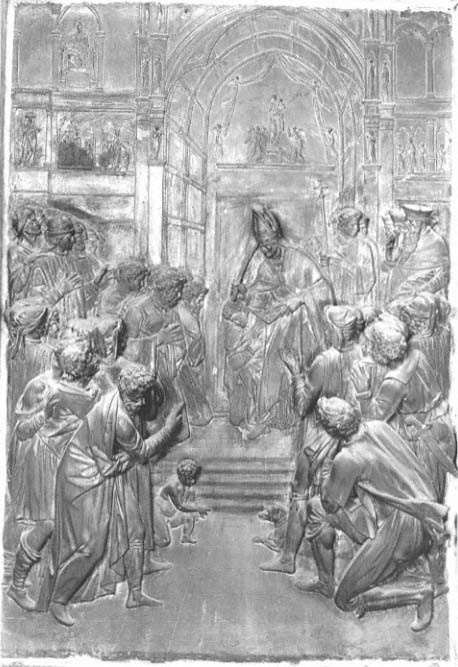
Figure 32.
Giambologna, Saint Antoninus Reconciling the Signoria , 1581–87. Bronze, 147 × 110 cm.
Salviati Chapel, San Marco, Florence.
Giambologna designed them with the viewpoint of the spectator in mind; the ground planes are tipped up and the perspective adjusted for easier viewing. The depth of the relief is also adapted to the viewer, with the heads and upper bodies of the figures sculpted in higher relief whereas the lower bodies are much flatter. Giambologna's manifest concern for the spectator in the Florentine chapel would have been expressed in the Grimaldi Chapel as well.
Fortunately, Giambologna's own burial chapel in Santissima Annunziata helps verify that the reliefs in the Grimaldi Chapel were placed beneath the statues. A set of the six Passion reliefs virtually identical to those mentioned in the Grimaldi contract decorates this chapel.[31] Apparently Giambologna was so pleased with the Grimaldi reliefs that he persuaded Grand Duke Ferdinando I to give the six replicas to him for his chapel, where he had them placed below the statues, undoubtedly reflecting the arrangement of the Grimaldi Chapel, for there is no reason to suppose that in the Annunziata chapel Giambologna would have departed from the earlier arrangement. Thus in the Grimaldi Chapel the spectator's viewpoint for the reliefs—in contrast to that for the reliefs in the Salviati Chapel—was calculated at about a foot above eye level (approximately five feet, five inches). The photograph of Christ Crowned with Thorns in the Annunziata chapel (Fig. 33) confirms this placement, and the calculation itself argues conclusively that the reliefs were beneath the statues. From a purely aesthetic point of view, the Grimaldi reliefs could have been placed over the Virtue statues, but then they would have been indecipherable and their entire narrative import would have been lost, an unacceptable solution. The contract for Giambologna's burial chapel, dated 1594, specifically gave the artist a free hand in devising his own program and decoration, as long as his choices did not violate the decrees of the Council of Trent.[32] Locating these Passion reliefs above the statues certainly would have violated the Council's demand for clear comprehension of the narrative.
The location of the Grimaldi reliefs under the Virtue statues would have followed a long-established tradition in painted and sculpted altarpieces of placing narrative scenes below standing figures. Thus the relationship of the reliefs to the statues above them is the same as that of predella panels to the painted figures of saints above them. Many fifteenth- and sixteenth-century sculpted altarpieces, such as Benedetto da Maiano's Altar of the Annunciation (Fig. 34) and Andrea Sansovino's Corbinelli altar (c. 1490, Santo Spirito, Florence), display the same for-
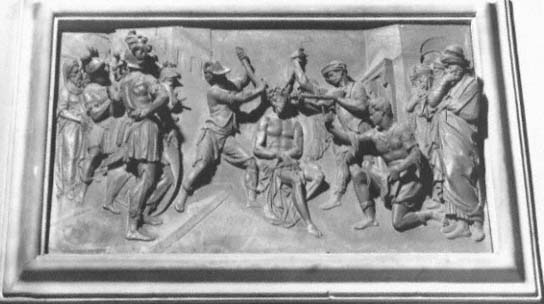
Figure 33.
Giambologna, Christ Crowned with Thorns , 1585–87. Bronze, 47 × 71 cm.
Soccorso Chapel, Santissima Annunziata, Florence.
mat. If Benedetto's altarpiece were dismantled and its statues and narrative scenes reassembled as separate parts on the walls of a chapel, the saints standing in niches above the reliefs, the resulting ensemble would look something like the Grimaldi Chapel. This configuration changes the relationship between the component parts and between those parts and the viewers, who now have a kinesthetic experience. No longer confined to one spot, as they were while contemplating Benedetto's work, they now feel impelled to move around the chapel, interacting as participants in the Passion narrative and responding actively to the Virtues. Concurrently, the space of the chapel is activated; sculpture, viewers, and space are interdependent parts of one complex.
Because the Grimaldi Chapel was a family funeral chapel, any recreation of the setting must account for the location of sarcophagi and the altar. Luca Grimaldi's will, dated 5 June 1611, three days before his death, gives only the instruction that he be buried in his chapel, the Chapel of the Holy Cross, in San Francesco di Castelletto. According to Federico Federici in his Scrutinio della Nobilità of 1641, Luca's wish was carried out and he was indeed buried there: "Luca Grimaldo q.
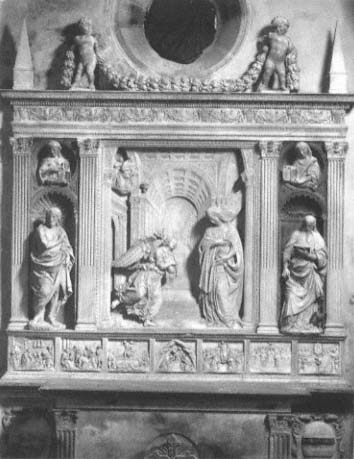
Figure 34.
Benedetto da Maiano, Altar of the Annunciation, c. 1474–75, marble.
Sant'Anna dei Lombardi, Naples.
francesci . . . fu sepolto nella sua Capella superbissima e Regia nella Chiesa de S. Francesco" (Luca Grimaldi, son of Francesco, was buried in his most splendid and royal chapel in the Church of San Francesco). Luca's father, Francesco, was already buried in the Chapel of the Holy Cross, as Giulio Pasqua records in a manuscript of 1610, Memoriè e Sepolcri che sono nelle chiese e ne' suburbi di Genova: "1544 Sepulcrum francisci di Grimaldis qm. Raphaelis."[33] Other members of the Grimaldi family must have been buried there as well.
Sarcophagi are found in crypts as well as attached to chapel walls. A major chapel like the Grimaldi often had a crypt, used for both relics and sarcophagi.[34] Giambologna's Salviati Chapel in Florence has one, as
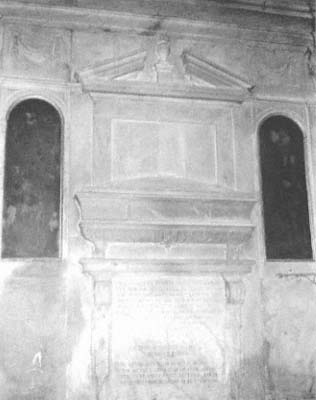
Figure 35.
Nicolò Doria Chapel, begun 1578 (detail).
San Matteo, Genoa.
does the earlier Genoese chapel of Andrea Doria in the apse of San Matteo. Although Doria's tomb is in the crypt of his chapel, there are sarcophagi located on the walls of other Doria family chapels in the nave of San Matteo—for instance, in Nicolò Doria's chapel (Fig. 35) to the left of the high altar and also on the walls of Ottaviano Doria's chapel to the right (c. 1587).[35] In all probability there were sarcophagi in the crypt of the Grimaldi Chapel and at least two, if not three, additional ones in the upper chapel on the side walls.[36] The horizontal format of the two paintings by Lomi (Fig. 16; Plate 13) makes it likely that below each was a sarcophagus, an arrangement like that on the altar wall of Giambologna's own burial chapel, the Soccorso (Fig. 36) in the Annunziata. To accommodate the wall sarcophagus in the Soccorso, the painting above was made smaller than the two paintings on the side
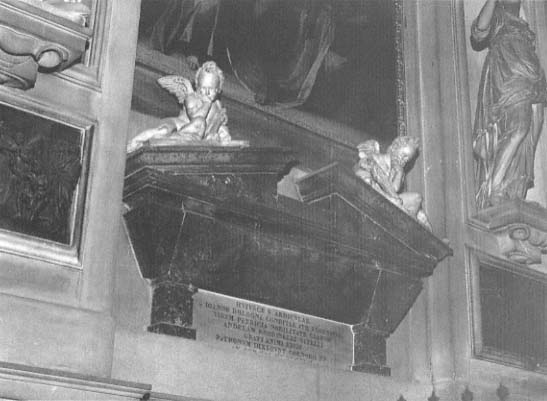
Figure 36.
Giambologna, Soccorso Chapel, c. 1594, altar wall.
Santissima Annunziata, Florence.
walls. And in the Grimaldi Chapel, as in the Soccorso, according to what we can surmise from Soprani and Ratti, a crucifix hung in the place of honor over the altar.
Visual considerations favor an island altar for the Grimaldi Chapel, similar to that in the Soccorso. Two statues in niches and an aedicula and pediment with bronze angels almost certainly made up the altar wall; the missing bronze statue of Luca Grimaldi was also probably located there. An altar attached to the wall would have required a truncated aedicula, thus distorting its proportions and crowding the statues in niches to either side. An island altar with the crucifix suspended above, in contrast, would have accommodated all these elements comfortably and would have allowed for a sarcophagus below the patron's statue as well.[37] The Lercari Chapel arrangement of Virtue statues in
niches flanking a central image (Fig. 30), already mentioned as a Genoese precedent for the Grimaldi, gives an idea of what I envision the configuration of the altar wall of the Grimaldi to have been.
To place the Passion scenes in their proper sequence is relatively easy. There is no reason to suppose that they appeared in any order other than that specified in the chapel contract, that is, Christ before Pilate, The Flagellation, Christ Crowned with Thorns, Ecce Homo, Pilate Washing His Hands , and The Way to Calvary . This order follows the dramatic narrative in John 18:28–19:17 and in the Canonical Office.[38] That the Grimaldi cycle began immediately to the left of the chapel entrance seems certain; the replicated cycle in Giambologna's own chapel begins on the left, a sequence dictated by the Western convention of reading from left to right. My analysis of the Passion cycle as a linear narrative, according to which the story unfolds sequentially, also argues for this arrangement (see Chapter 5).
Determining the order of the Virtues in the Grimaldi Chapel, however, is problematic. The contract specified representations of the three theological virtues—faith, hope, and charity—and three, instead of the customary four, cardinal virtues: justice, fortitude, and prudence. In the final execution, as we have seen, temperance was represented rather than prudence, which appeared elsewhere or perhaps in some other guise. In determining the specific location of each Virtue it would be helpful to discover a visual or textual tradition relating specific virtues to specific Passion scenes, but none exists. In the late Middle Ages there does seem to be a tradition associating patience with the scene of Christ Bearing the Cross (patience being one aspect of fortitude) in, for example, Saint Hildegard of Bingen's Liber Scivias , the Biblia Pauperum , and vernacular literature such as Chaucer's Parson's Tale .[39] But this hardly provides a complete program. One much later text links virtues and the Passion, but only in the most general way: the 1566 catechism, written consequent to the deliberations of the Council of Trent, says that Christ exhibited all the virtues in his Passion, namely, patience, humility, charity, meekness, obedience, and firmness of soul.[40] No special events of the Passion exemplifying these or other virtues are singled out, however. In the rare instances when their representations are combined with the Passion in a single monument, there is no discernible pattern to the juxtaposition. On the original rood screen in Sainte-Waudru, Mons (Fig. 12), where Giambologna had worked as a young apprentice to the Flemish sculptor Jacques Du Broeucq, the seven Virtues stood beside
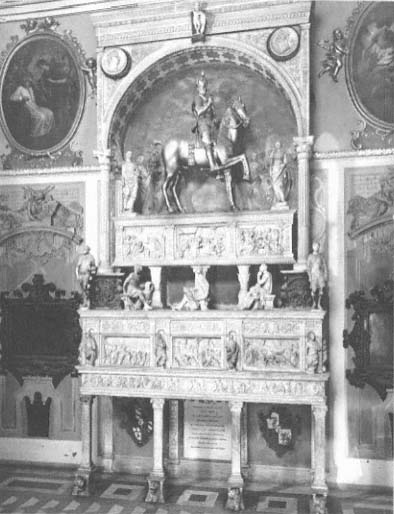
Figure 37.
Giovanni Antonio Amadeo, Bartolommeo Colleoni monument, c. 1473–80, marble.
Colleoni Chapel, Bergamo.
Passion scenes, but it is not possible to make specific connections.[41] Nor is there any detectable thematic relationship between Virtues and Passion scenes in Bartolommeo Colleoni's monument (Fig. 37) in his chapel in Bergamo, where the Virtues flank the Passion scenes.[42]
On some monuments the placement of the Virtues accords with their hierarchical importance, as on the Mons rood screen, where the three theological Virtues were above the four cardinal Virtues. Charity held the honored central position at the top, for as Saint Paul, 1 Corinthians
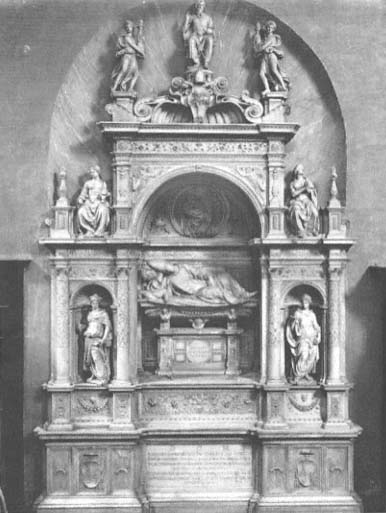
Figure 38.
Andrea Sansovino, Sforza tomb, c. 1505, marble.
Santa Maria del Popolo, Rome.
13:13, makes clear, "So faith, hope, love, abide, these; but the greatest of these is love." Furthermore, in its sixth session, in 1547, the Council of Trent reaffirmed the importance of charity, along with faith and hope, in the doctrine of justification.[43] And if we look at Virtues on Italian tomb monuments, we find that the theological Virtues usually occupy the more esteemed positions.[44]Faith, Charity , and Hope encircle the head of the recumbent effigy in Antonio Pollaiuolo's tomb of Sixtus IV, while the four cardinal Virtues in relief are seated in pairs on either side
of the body, Prudence opposite Temperance and Fortitude opposite Justice . Andrea Sansovino's twin tombs for the Sforza (Fig. 38) and Basso families in Santa Maria del Popolo, Rome, display two theological and two cardinal Virtues each. Below God the Father, Charity, in the form of the Madonna and Child , and Faith and Hope occupy the attic portion while Justice and Prudence , on the Sforza tomb, and Fortitude and Temperance , on the Basso tomb, stand in niches flanking the sarcophagus.
For the Grimaldi Chapel, which had three walls, each with niches and a central image, the Virtues must have been grouped in pairs. In proposing which Virtue stood in which niche, I have considered both design and theology, particularly the importance of faith, hope, and charity in church thought.[45] Thus, Fortitude (Plate 6) and Justice (Fig. 4), representing those virtues most closely associated with worldly concerns, would face each other, one to the left and the other to the right of the chapel entrance, their composition determining their location. The best placement for Fortitude —with her left hand extended, her right pulled back, and her torso turned slightly to her right—is to the spectator's left, whereas that for Justice is to the spectator's right.
Hope (Plate 2), the active, and Temperance (Plate 5), the contemplative virtue, would have formed a complementary pair facing one another in the inner niches of the lateral walls. Hope , her body tightly coiled with intense yearning, gazes up toward the source of salvation; her best placement is to the viewer's left. Temperance , who can be viewed comfortably from any position, counterbalances the passion of Hope and fits well on the right wall of the chapel, to the spectator's right.
Charity (Plate 4), as the first theological Virtue, should be near the altar, her design allowing for a wide range of viewpoints; these considerations place her securely on the altar wall. She could occupy either niche there. Her group, comprising three figures, is the most complex design of all the Virtues. Her pronounced contrapposto stance makes a place for one child in the hollow of her body, and the resulting turn of her head and shoulder to her right permits the other child to stand against her right leg. Faith (Plate 3), as one of the theological virtues, makes a logical companion to Charity , and her contrapposto stance with her weight on her inside leg complements that of Charity , whose weight is also on her inside leg.[46] Although she can be viewed from several points, the most satisfactory are front and left; her niche would be to the left of the altar, leaving Charity to occupy the niche on the right. To summarize my proposal: Fortitude to the left and Justice to the right at the entrance to
the chapel, followed by Hope to the left and Temperance to the right, and finally Faith to the left and Charity to the right on the altar wall.
Using the reconstructed appearance of the Grimaldi Chapel I propose here (Figs. 17, 18), I proceed in the chapters that follow to unravel the meaning of the decorative program and to assess Giambologna's contribution to visual narrative at a crucial stage in its history.